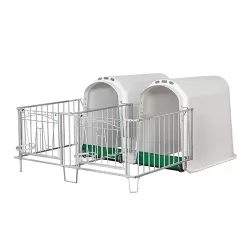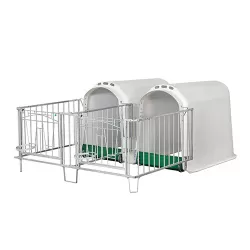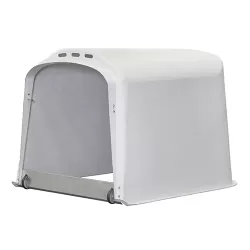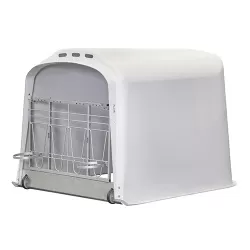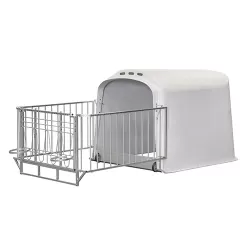Pair housing
Cows are herd animals and feel comfortable in company. However, in practice, calves are often housed individually during the first weeks of their lives in order to prevent infections. Dual accommodation – keeping and raising calves in pairs – is growing in popularity. The advantages are crystal clear: you can read all about them in this newsletter!
More natural behaviour
Having company is important for calves. By raising calves in pairs, they learn to play with peers from the first days of life. As a result, they will automatically display more natural behaviour at a later age. Having social contact at an early age helps calves learn social interactions faster and also improves their other learning skills. Socialised calves also display more curiosity and less fear in later life. Various studies have shown that calves experience less stress if they are reared in pairs. A study by the University of British Columbia, for example, revealed that the number of times a calf mooed was reduced by half when calves were together.
Seeing others eat encourages eating
Rearing in pairs also has a positive effect on feed intake. According to the study by the University of British Columbia, an additional feed intake of 30% can be achieved during the milk period. Calves encourage each other to eat new and unfamiliar food. This also makes the transition from milk to feed smoother. Research shows that calves reared in pairs eat an average of over 1 kg per day from day 1 after they stop receiving milk. This compares to individually reared calves who only start eating on day 2. These calves only exceed a daily intake of 1 kg on day 4. They lose weight in the first few days, whereas calves reared in pairs do not.
Lower risk of disease
Research shows that the risk of disease is significantly lower when calves are reared in pairs. The risk of disease in the period up to weaning was compared between individual rearing and rearing in pairs. Calves raised in pairs have about 2/3 less diarrhoea and 50% less pneumonia. In fact, pairs of a similar age form a so-called 'infection unit', which achieves a reduced risk of infection.
Little risk of sucking
Several studies mention the risk of calves sucking each other as a possible drawback of housing them in pairs. In this context, sucking means excessive sucking of ears, navels and teats, which can lead to infection. Excessive sucking is a sign that calves are not able to adequately practice natural behaviour. To prevent this, a number of steps should be taken. A teat bucket combined with ample milk supply helps satisfy this natural need and keeps the calves calmer. In addition, gradual weaning combined with an adequate food supply and space to move around is important to stop the urge to suckle. A sufficient supply of good quality roughage ensures that calves spend more time eating and ruminating.
Accommodation for pairs
Rearing young calves in pairs requires a different type of accommodation. The dimensions of CalfOTel's new XL-2 model are in line with European regulations for keeping and rearing calves in groups. The model is extra wide and extra high so that it can comfortably accommodate two calves. The entrance is also extra large, making it easy for calves to walk in and out at the same time. Despite its size, the model is easy to move around thanks to the built-in wheels and the handle on the back. Another advantage of the XL-2 is that the feed openings in the fence are adjustable. The model is therefore suitable for both young and older calves and for small and large breeds. This allows calves to remain safely in their familiar hutches for longer. As a result, this dual accommodation saves the farmer labour and costs and spares the calves an additional stress when they are moved. In addition to the XL-2, CalfOTel's range includes further options for dual accommodation, such as the CalfOTel Hybrid for outdoors and the Open Top Premium Duo and Indoor Combo systems for indoors. The Small/Plus and Comfort are also available with Duo fencing. A conversion kit is available for existing hutches on the farm. This allows the standard 4-part fence to be converted into a Duo fence. The pivoting fence in the middle allows the calves to be kept individually during the first few days.

